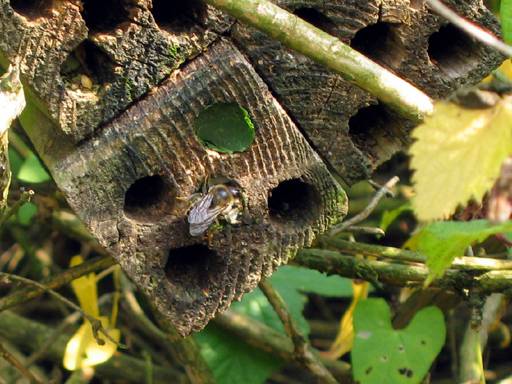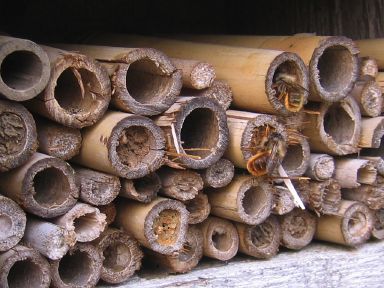Solitary bees
Many other species of bee that visit gardens are solitary, rather than social like the bumblebee. In summer they make a nest, usually in a hole in wood or in the ground, lay eggs in it and provide provisions in the form of honey and/or pollen, then die off as the cold weather arrives. The eggs hatch the following spring or early summer and the young bees then find a mate and the cycle of egglaying begins again. Solitary bees therefore do not survive to see their own young develop.
There are many species of solitary wasp that have a similar lifecycle, the key difference being that they provide live meat to feed their young, typically stinging a caterpillar to paralyse it and keep it fresh until eaten the following spring.
One of the commoner solitary bees in gardens is the leafcutter bee (below), which uses pieces cut from leaves to line its nest in a hole in wood. Another frequent bee in gardens is the wool carder bee, that combs hairs from furry plants to line its nest (top right).


Artificial homes
Leafcutter and other bees will readily adopt artificial homes. As illustrated bottom left, cut some (untreated) 5cm x 5cm softwood into 20 cm lenths, then drill several holes 6mm–10mm in diameter and 15 cm or so deep into one end. Strap several of these together and hang them under a bush or under the eaves of a low building, well sheltered and with the holes facing south. Inspect them in the summer and you will be able to see when holes have been used for nests and also when the young have hatched and dug their way out, after which you can redrill or clean out the holes. Better still, put them somewhere you go past every day and there is a good chance you will see the bees coming and going to furnish their nests. Be patient because they seem to be more acceptable to bees when weathered.
An alternative, shown above, is to stick short lengths of cane or hollow plant stems inside a wooden box – an old bird box with the front removed is ideal.
